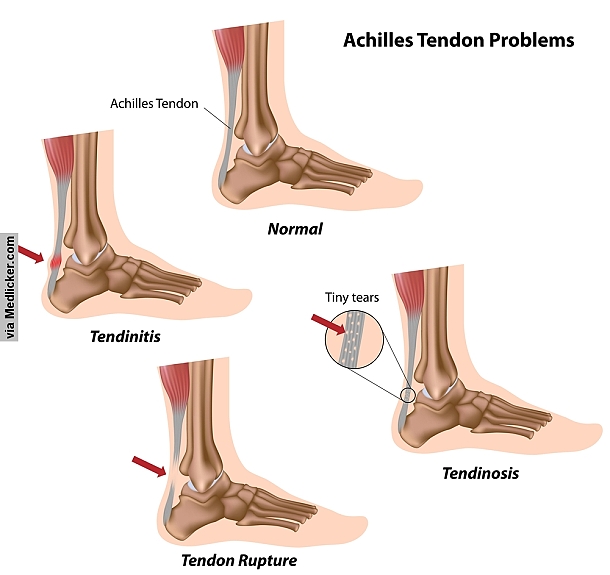Achilles tendinitis is a condition that causes pain on the back of your leg near your heel. The Achilles tendon is strong and can take huge amounts of stress, but it can also develop tendinitis if over used.
Symptoms
- Pain after exercising
- Thickening of the tendon
- Pain and stiffness in the tendon in the morning
- Pain at the back of the heel
- Swelling
- Bone spur
Risk Factors
You are more likely to develop Achilles tendinitis:
- If you are starting a sudden exercise regimen that puts too much stress on the tendon
- You have extra bone growth
- You do very intense work out sessions
Diagnosis
Based on the symptoms, your doctor will examine your foot and look for signs of pain and discomfort or immobility. He will also run the following tests to rule out any other possibilities:
- X-Ray
- MRI scan

Treatment
Minor to moderate Achilles tendon injuries should heal on their own. To speed the process, you can:
- Resting plenty
- Applying ice packs on inflamed areas
- Exercising in moderation
- Practice stretching and strengthening exercises as recommended by your doctor, physical therapist, or other health care provider.
- Use a heel lift. Your doctor may recommend that you wear an insert in your shoe while you recover. It will help protect your Achilles tendon from further stretching.
- Take anti-inflammatory painkillers. Nonsteroidal anti-inflammatory drugs (NSAIDs) like ibuprofen and naproxen will help with pain and swelling. Follow the instructions on the label to help prevent side effects, such as bleeding and ulcers. Take them with food. Check with your doctor first if you have any allergies, medical problems or take any other medication. If you need them for longer than 7 to 10 days, call your doctor.
- Raise (elevate) your leg. Prop your leg up on a pillow when you’re sitting or lying down.
- Compress your leg. Use an elastic bandage around the lower leg and ankle to keep down swelling.
- Ice it. Ice your injury for up to 20 minutes at a time as needed.
- Rest your leg. Avoid putting weight on your leg as best you can. You may need crutches.
- Getting Physiotherapy
Medication and Surgery
Medication for Achilles tendinitis includes steroidal and non-steroidal drugs.
Surgery should be considered a last resort, only if there are no signs of the pain reducing. Types of surgery include:
- Debridement and repair – This is recommended only if the tendon is less than 50% damaged
- Gastrocnemius recession (surgical lengthening of the calf muscle)
- Debridement with tend on transfer – This is recommended if the tendon is over 50% damaged
Prevention:
- Cut down on uphill running.
- Wear shoes with good support that fit well.
- Stop exercising if you feel pain or tightness in the back of your calf or heel.

Post a comment